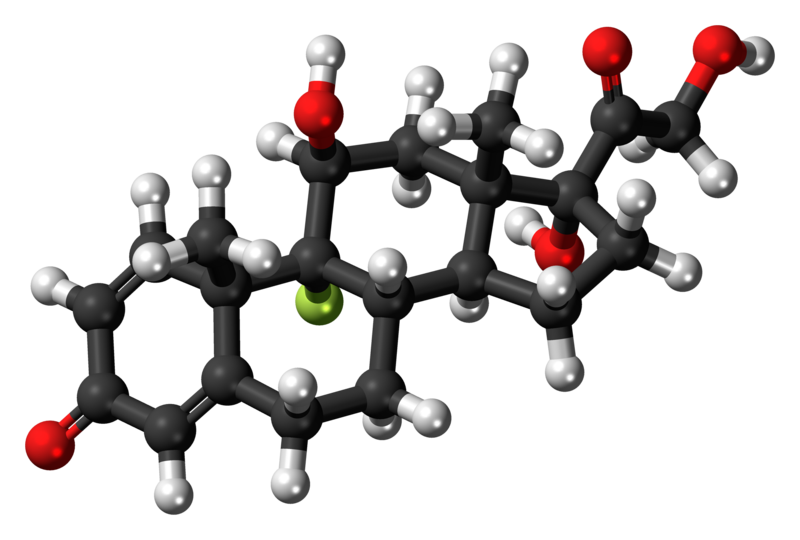Dexamethasone (ophthalmic)
Editor-In-Chief: C. Michael Gibson, M.S., M.D. [1]; Associate Editor(s)-in-Chief: Adeel Jamil, M.D. [2]
Disclaimer
WikiDoc MAKES NO GUARANTEE OF VALIDITY. WikiDoc is not a professional health care provider, nor is it a suitable replacement for a licensed healthcare provider. WikiDoc is intended to be an educational tool, not a tool for any form of healthcare delivery. The educational content on WikiDoc drug pages is based upon the FDA package insert, National Library of Medicine content and practice guidelines / consensus statements. WikiDoc does not promote the administration of any medication or device that is not consistent with its labeling. Please read our full disclaimer here.
Overview
Dexamethasone (ophthalmic) is an anti-inflammatory agent that is FDA approved for the treatment of steroid responsive inflammatory conditions of the palpebral and bulbar conjunctiva, cornea, and anterior segment of the globe, allergic conjunctivitis, acne rosacea, superficial punctate keratitis, herpes zoster keratitis, iritis, cyclitis, corneal injury from chemical, thermal burns, or penetration of foreign bodies, and steroid responsive inflammatory conditions of the external auditory meatus, such as allergic otitis externa, selected purulent and nonpurulent infective otitis externa. Common adverse reactions include glaucoma with optic nerve damage, visual acuity and visual field defects, posterior subcapsular cataract formation, secondary ocular infection from pathogens including herpes simplex, and perforation of the globe.
Adult Indications and Dosage
FDA-Labeled Indications and Dosage (Adult)
- For the treatment of the following conditions:
Ophthalmic:
- Steroid responsive inflammatory conditions of the palpebral and bulbar conjunctiva, cornea, and anterior segment of the globe, such as allergic conjunctivitis, acne rosacea, superficial punctate keratitis, herpes zoster keratitis, iritis, cyclitis, selected infective conjunctivitis when the inherent hazard of steroid use is accepted to obtain an advisable diminution in edema and inflammation; corneal injury from chemical or thermal burns, or penetration of foreign bodies.
Otic:
- Steroid responsive inflammatory conditions of the external auditory meatus, such as allergic otitis externa, selected purulent and nonpurulent infective otitis externa when the hazard of steroid use is accepted to obtain an advisable diminution in edema and inflammation.
Dosing Information
- The duration of treatment will vary with the type of lesion and may extend from a few days to several weeks, according to therapeutic response. Relapses, more common in chronic active lesions than in self-limited conditions, usually respond to retreatment.
Eye:
- Instill one or two drops of solution into the conjunctival sac every hour during the day and every two hours during the night as initial therapy. When a favorable response is observed, reduce dosage to one drop every four hours. Later, further reduction in dosage to one drop three or four times daily may suffice to control symptoms.
Ear:
- Clean the aural canal thoroughly and sponge dry. Instill the solution directly into the aural canal. A suggested initial dosage is three or four drops two or three times a day. When a favorable response is obtained, reduce dosage gradually and eventually discontinue.
- If preferred, the aural canal may be packed with a gauze wick saturated with solution. Keep the wick moist with the preparation and remove from the ear after 12 to 24 hours. Treatment may be repeated as often as necessary at the discretion of the physician.
Off-Label Use and Dosage (Adult)
Guideline-Supported Use
There is limited information regarding Off-Label Guideline-Supported Use of Dexamethasone (ophthalmic) in adult patients.
Non–Guideline-Supported Use
There is limited information regarding Off-Label Non–Guideline-Supported Use of Dexamethasone (ophthalmic) in adult patients.
Pediatric Indications and Dosage
FDA-Labeled Indications and Dosage (Pediatric)
There is limited information regarding Dexamethasone (ophthalmic) FDA-Labeled Indications and Dosage (Pediatric) in the drug label.
Off-Label Use and Dosage (Pediatric)
Guideline-Supported Use
There is limited information regarding Off-Label Guideline-Supported Use of Dexamethasone (ophthalmic) in pediatric patients.
Non–Guideline-Supported Use
There is limited information regarding Off-Label Non–Guideline-Supported Use of Dexamethasone (ophthalmic) in pediatric patients.
Contraindications
- Epithelial herpes simplex keratitis (dendritic keratitis).
- Acute infectious stages of vaccinia, varicella and many other viral diseases of the cornea and conjunctiva.
- Mycobacterial infection of the eye.
- Hypersensitivity to any component of this product, including sulfites.
- Perforation of a drum membrane.
Warnings
- Prolonged use may result in ocular hypertension and/or glaucoma, with damage to the optic nerve, defects in visual acuity and fields of vision, and posterior subcapsular cataract formation. Prolonged use may suppress the host response and thus increase the hazard of secondary ocular infections. In those diseases causing thinning of the cornea or sclera, perforations have been known to occur with the use of topical corticosteroids. In acute purulent conditions of the eye or ear, corticosteroids may mask infection or enhance existing infection. If these products are used for 10 days or longer, intraocular pressure should be routinely monitored even though it may be difficult in children and uncooperative patients.
- Employment of corticosteroid medication in the treatment of herpes simplex other than epithelial herpes simplex keratitis, in which it is contraindicated, requires great caution; periodic slit-lamp microscopy is essential.
- This product contains sodium bisulfite, a sulfite that may cause allergic-type reactions including anaphylactic symptoms and life-threatening or less severe asthmatic episodes in certain susceptible people. The overall prevalence of sulfite sensitivity in the general population is unknown and probably low. Sulfite sensitivity is seen more frequently in asthmatic than in nonasthmatic people.
PRECAUTIONS
General
- The possibility of persistent fungal infections of the cornea should be considered after prolonged corticosteroid dosing.
- There have been reports of bacterial keratitis associated with the use of multiple dose containers of topical ophthalmic products. These containers had been inadvertently contaminated by patients who, in most cases, had a concurrent corneal disease or a disruption of the ocular epithelial surface.
Adverse Reactions
Clinical Trials Experience
- Glaucoma with optic nerve damage, visual acuity and field defects, posterior subcapsular cataract formation, secondary ocular infection from pathogens including herpes simplex, perforation of the globe.
- Rarely, filtering blebs have been reported when topical steroids have been used following cataract surgery.
- Rarely, stinging or burning may occur.
Postmarketing Experience
There is limited information regarding Dexamethasone (ophthalmic) Postmarketing Experience in the drug label.
Drug Interactions
There is limited information regarding Dexamethasone (ophthalmic) Drug Interactions in the drug label.
Use in Specific Populations
Pregnancy
- Dexamethasone has been shown to be teratogenic in mice and rabbits following topical ophthalmic application in multiples of the therapeutic dose.
- In the mouse, corticosteroids produce fetal resorptions and a specific abnormality, cleft palate. In the rabbit, corticosteroids have produced fetal resorptions and multiple abnormalities involving the head, ears, limbs, palate, etc.
- There are no adequate or well-controlled studies in pregnant women. Dexamethasone sodium phosphate ophthalmic solution should be used during pregnancy only if the potential benefit to the mother justifies the potential risk to the embryo or fetus. Infants born of mothers who have received substantial doses of corticosteroids during pregnancy should be observed carefully for signs of hypoadrenalism.
Pregnancy Category (AUS):
There is no Australian Drug Evaluation Committee (ADEC) guidance on usage of Dexamethasone (ophthalmic) in women who are pregnant.
Labor and Delivery
There is no FDA guidance on use of Dexamethasone (ophthalmic) during labor and delivery.
Nursing Mothers
- Topically applied steroids are absorbed systemically. Therefore, because of the potential for serious adverse reactions in nursing infants from dexamethasone sodium phosphate, a decision should be made whether to discontinue nursing or discontinue the drug, taking into account the importance of the drug to the mother.
Pediatric Use
- Safety and effectiveness in pediatric patients have not been established.
Geriatic Use
There is no FDA guidance on the use of Dexamethasone (ophthalmic) in geriatric settings.
Gender
There is no FDA guidance on the use of Dexamethasone (ophthalmic) with respect to specific gender populations.
Race
There is no FDA guidance on the use of Dexamethasone (ophthalmic) with respect to specific racial populations.
Renal Impairment
There is no FDA guidance on the use of Dexamethasone (ophthalmic) in patients with renal impairment.
Hepatic Impairment
There is no FDA guidance on the use of Dexamethasone (ophthalmic) in patients with hepatic impairment.
Females of Reproductive Potential and Males
There is no FDA guidance on the use of Dexamethasone (ophthalmic) in women of reproductive potentials and males.
Immunocompromised Patients
There is no FDA guidance one the use of Dexamethasone (ophthalmic) in patients who are immunocompromised.
Administration and Monitoring
Administration
- Ophthalmic
- Otic
Monitoring
There is limited information regarding Dexamethasone (ophthalmic) Monitoring in the drug label.
IV Compatibility
There is limited information regarding the compatibility of Dexamethasone (ophthalmic) and IV administrations.
Overdosage
There is limited information regarding Dexamethasone (ophthalmic) overdosage. If you suspect drug poisoning or overdose, please contact the National Poison Help hotline (1-800-222-1222) immediately.
Pharmacology
Mechanism of Action
- Dexamethasone sodium phosphate suppresses the inflammatory response to a variety of agents and it probably delays or slows healing. No generally accepted explanation of these steroid properties have been advanced.
Structure
- Dexamethasone Sodium Phosphate Ophthalmic Solution USP, is a sterile, topical steroid solution. The active ingredient is represented by the following structural formula:

- Glucocorticoids are adrenocortical steroids, both naturally occurring and synthetic. Dexamethasone is a synthetic analog of naturally occurring glucocorticoids (hydrocortisone and cortisone). Dexamethasone sodium phosphate is a water soluble, inorganic ester of dexamethasone. It is approximately three thousand times more soluble at 25°C than hydrocortisone.
Pharmacodynamics
There is limited information regarding Dexamethasone (ophthalmic) Pharmacodynamics in the drug label.
Pharmacokinetics
There is limited information regarding Dexamethasone (ophthalmic) Pharmacokinetics in the drug label.
Nonclinical Toxicology
There is limited information regarding Dexamethasone (ophthalmic) Nonclinical Toxicology in the drug label.
Clinical Studies
There is limited information regarding Dexamethasone (ophthalmic) Clinical Studies in the drug label.
How Supplied
Dexamethasone Sodium Phosphate Ophthalmic Solution USP 0.1%, is supplied in a plastic squeeze bottle with a controlled drop tip in the following size: 5 mL - NDC 24208-720-02
Revised: January 2013
Bausch & Lomb Incorporated
Tampa, FL 33637
©Bausch & Lomb Incorporated
9100202 (Folded) 9100302 (Flat)
Storage
- Storage: Store between 15°-25°C (59°-77°F).
- DO NOT USE IF IMPRINTED NECKBAND IS NOT INTACT.
- KEEP OUT OF REACH OF CHILDREN.
Images
Drug Images
{{#ask: Page Name::Dexamethasone (ophthalmic) |?Pill Name |?Drug Name |?Pill Ingred |?Pill Imprint |?Pill Dosage |?Pill Color |?Pill Shape |?Pill Size (mm) |?Pill Scoring |?NDC |?Drug Author |format=template |template=DrugPageImages |mainlabel=- |sort=Pill Name }}
Package and Label Display Panel
NDC 24208-720-02
Bausch & Lomb
Dexamethasone Sodium Phosphate Ophthalmic Solution USP, 0.1%
Dexamethasone Phosphate Equivalent (Sterile)
Rx only
[icon- eye] [icon- 0.1%] [icon- solution] [icon- 5 mL]

{{#ask: Label Page::Dexamethasone (ophthalmic) |?Label Name |format=template |template=DrugLabelImages |mainlabel=- |sort=Label Page }}
Patient Counseling Information
- Patients should be instructed to avoid allowing the tip of the dispensing container to contact the eye or surrounding structures.
- Patients should also be instructed that ocular preparations, if handled improperly, can become contaminated by common bacteria known to cause ocular infections. Serious damage to the eye and subsequent loss of vision may result from using contaminated solutions.
- Patients should also be advised that if they develop an intercurrent ocular condition (e.g., trauma, ocular surgery or infection , they should immediately seek their physician's advice concerning the continued use of the present multidose container.
- One of the preservatives in dexamethasone sodium phosphate ophthalmic solution, benzalkonium chloride, may be absorbed by soft contact lenses. Patients wearing soft contact lenses should be instructed to wait at least 15 minutes after instilling dexamethasone sodium phosphate ophthalmic solution before they insert their lenses.
Precautions with Alcohol
Alcohol-Dexamethasone (ophthalmic) interaction has not been established. Talk to your doctor about the effects of taking alcohol with this medication.
Brand Names
- Dexamethasone[1]
Look-Alike Drug Names
There is limited information regarding Dexamethasone (ophthalmic) Look-Alike Drug Names in the drug label.
Drug Shortage Status
Price
References
The contents of this FDA label are provided by the National Library of Medicine.

